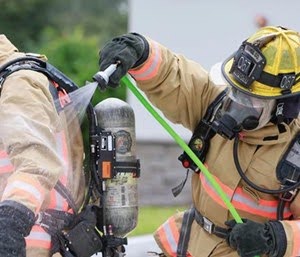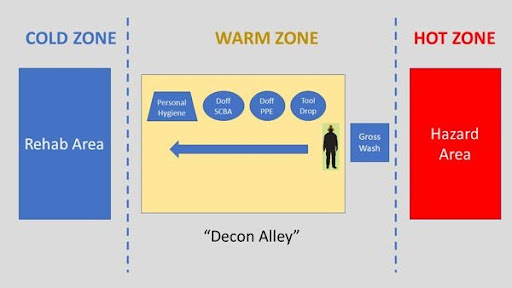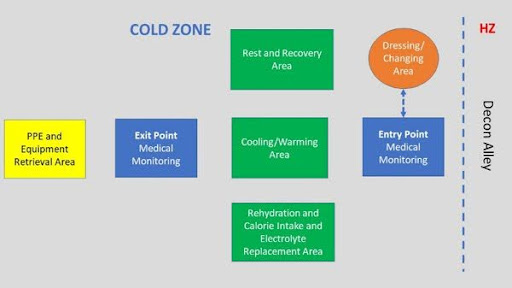Decontamination Process
Firefighter exposure to dangerous chemicals and carcinogenic particulates are a known leading cause of cancer among firefighters. However, implementing a clear decon alley process at facility fires can help to reduce exposure to the individual firefighter, as well as eliminate the spread risk of dangerous chemicals back to the fire station.
Keep reading to learn the steps your fire department should take to create an effective decontamination process while on the scene of a building fire.
What Is the NFPA 1584 Rehab Requirement?
The NFPA 1584, “Standard on the Rehabilitation Process for Members During Emergency Operations and Training Exercises,” went into effect as a requirement in January 2007. This standard requires fire departments to have standard operating guidelines that detail how they provide rehabilitation at fire scenes and training exercises. Rehab processes are required at training exercises where firefighters are expected to work for one hour or more. This standard also mandates rehab procedures must be integrated into a department’s Incident Management System for proper tracking accountability.
The NFPA 1584 requirement aims to:
- Educate firefighters and departments on when and how to implement rehab procedures
- Give the supplies, equipment, and medical assistance to firefighters when they need it
- Provide a resource for those unable or unwilling to acknowledge when they are fatigued
How to Set Up a Decon Alley On-Scene
A Decon Alley, or Decontamination Alley, is an essential process to ensure on-scene firefighters are free from dangerous chemicals and can safely enter the rehab and recovery process.
A Decon Alley is comprised of five main components including:
- Gross Wash (level 1 decon)
- Drop Equipment
- Doff PPE
- Removal of SCBA Facepiece
- Personal Hygiene
Once all those steps are completed and the chemical exposure risk is mitigated, only then can firefighters proceed to the rehabilitation portion of the recovery process.
The Decon Alley is divided into three sections, the Hot Zone, the Warm Zone, and the Cold Zone. The Hot Zone is the main entry point in the Decon Alley and is considered a hazard area. The Warm Zone consists of the actual chemical and particulate exposure mitigation progress. Lastly, the Cold Zone is the rehab and recovery section where firefighters can exit once their physical, mental, and emotional levels improve.
In the Warm Zone of Decon Alley, firefighters go through a several step process to clean their gear and themselves to eliminate as much harmful chemical exposure as possible. The Warm Zone is where the five decontamination steps take place mentioned above. The first step in the decontamination process is a Gross Wash, or Gross Decon. A Gross Wash utilizes warm, low water pressure to wash soot and particles from a firefighter’s gear, without driving it into the fabric. If this initial step is not conducted correctly, the rest of the decontamination process will not be effective. Additionally, it is essential that all assisting personnel within decon alley need to be in proper PPE gear to protect themselves from any contaminated water and inhalation hazards during the rinsing and doffing process.
How to Create a Rehab Process in Decon Alley
Once a firefighter has washed their gear, removed their gear, and cleaned themselves, they can enter the rehab area. The final section of Decon Alley is the Cold Zone with the Rehab Area. The rehab process is broken up into four main steps including:
- Initial Medical Monitoring
- Firefighter Rest and Recovery (including cooling/ warming, rehydration and electrolytes, and caloric intake)
- Final Medical Evaluation
- Firefighter Released and Exit Process (including back to operations, fire station, or hospital)
Firefighter Health & Safety
A standardized and thorough rehab process is essential to firefighter health and safety. These steps will help firefighters recover from exposure to extreme heat and chemicals. Their vital signs are monitored to ensure proper recovery on scene before they can continue working or return to the fire station.
Rehabilitation processes, as part of decon alley, are a requirement for fire departments while on scene of a fire emergency. A comprehensive Decon Alley and rehab procedure will help to reduce firefighter exposure to hazardous conditions and prioritize recovery. Safety needs to be the priority during and after an active fire, a Decon Alley and rehab process will guarantee that.
In addition to his leadership role at Ward Fire Equipment,
John May has more than 30 years of experience in the Fire Service. John is a Level I & II Fire instructor in the State of NY.




